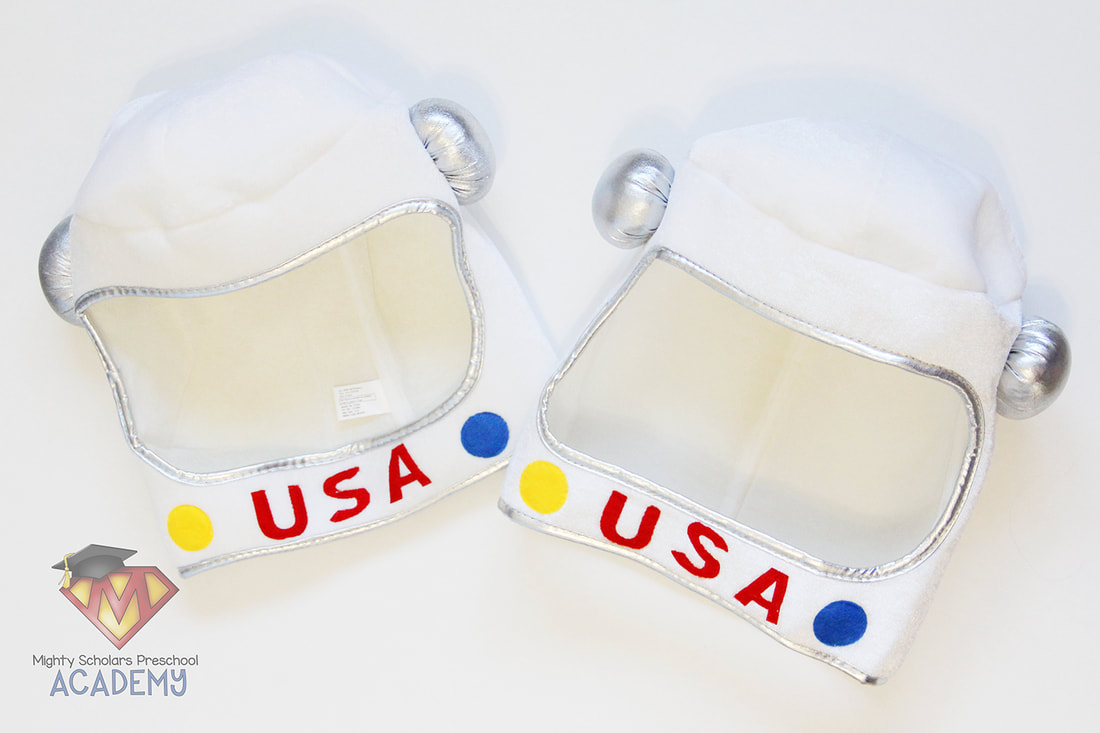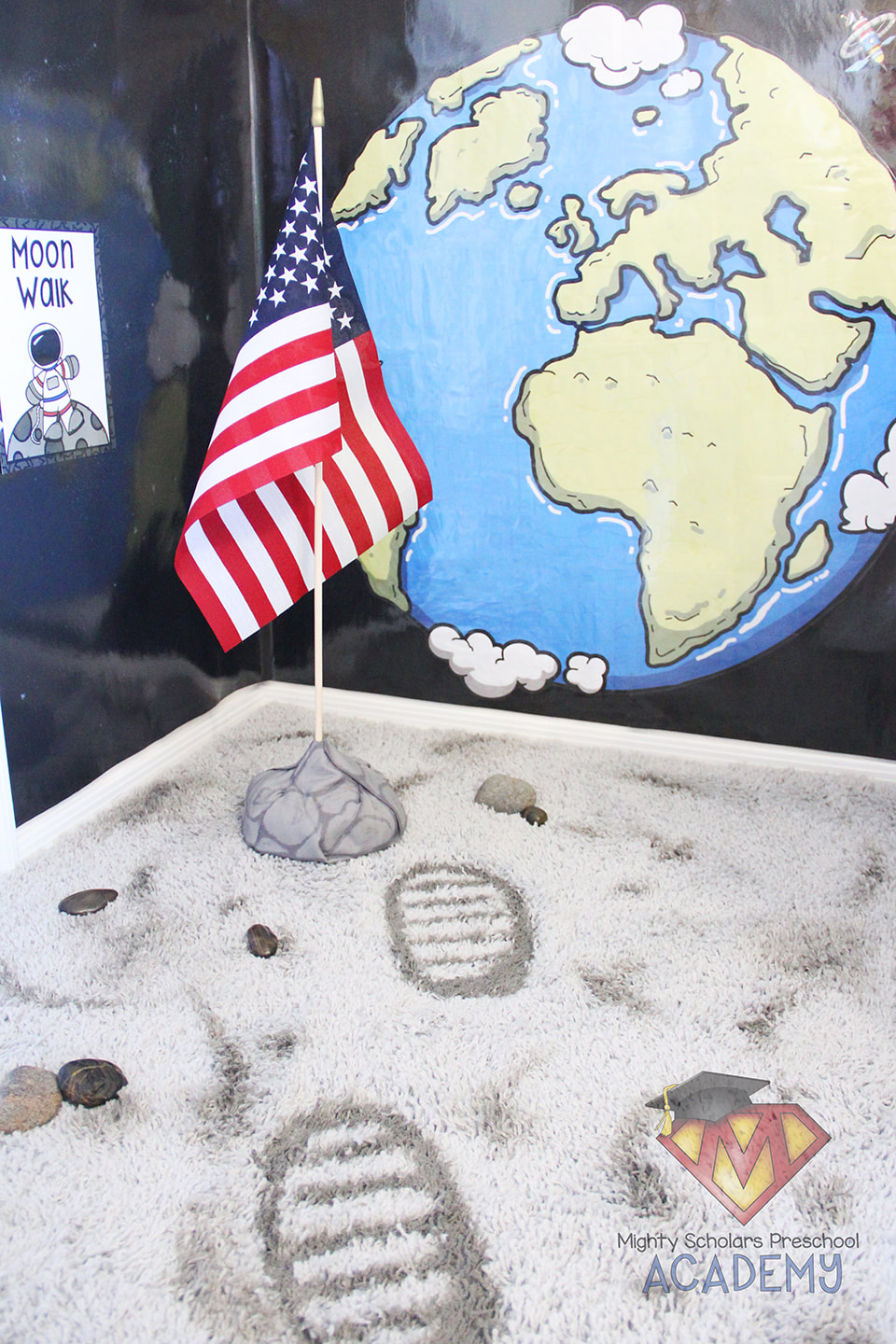|
Space exploration is an exciting unit for all my scholars.
During our two week unit on space, I cover the history of space travel, plus the method of collecting and analyzing science samples. I picture walk my scholars through the first Moon landing and what it takes to be an astronaut. To bring the first Moon landing into our classroom, I made sure to provide familar sights, from our picture walk.
Clothing needs to fit comfortably over day clothes, be easy to clean and implement independence.
Four scholars are allowed in the Imagination Center, at a time. Two Mission Control shirts and two astronaut shirts with soft hats are included. I sewed the simplified versions of a shirt for Mission Control, without closures. The decals were printed onto iron-on transfer paper, made specifically for dark fabrics. The official patch images were available as clipart and the back Mission Control decal is a FREEBIE at the bottom of this post. The astronaut shirts are an Amazon purchase (link at the bottom of the post). They have an easy hook and loop closure. The soft helmets are also an online purchase, that are not only easy to store, but machine washable. The wonderful signs and labels are from the talented Pocket of Preschool Space Station Dramatic Play Pack, found on Teachers Pay Teachers, HERE.
Mission Control is one of the most challenging and engaging parts of the center.
The mission control center is made from peg board and wood corner brackets, painted black, with strip lights attached to the back. The "monitors" are frames from the dollar store (glass has been removed), with laminated hi-resolution images printed from NASA's public historical archives. Scholars can recall the sequence from our picture walk, about exploration to the Moon. The red and black switches are from the dollar store. The other elements were printed and laminated from the Pocket of Preschool Space Station Dramatic Play Pack. I covered the earth with a repurposed plastic dome, saved from a holiday package. The keyboard offers letter/number recognition.
The first bootprints on the Moon, will remain for thousands of years.
During our picture walk, at the beginning of our space unit, my scholars learn about the historical landing of the Apollo 11 Lunar Module. Pictures of the famous bootprints, left by astronauts Neil Armstrong and Edwin "Buzz" Aldrin, were recreated using dark gray acrylic paint, on a 4x6 gray shag rug (Moon). My scholars learn that there isn't any erosion on the Moon surface and the marks left there by man and machines will remain for thousands of years. The American flag that was placed on the Moon by the two astronauts, was recreated with a rice weighted base, covered in hotglued, painted fabric. Real rocks are set around the Moon (rug) surface, to equip my scholars with "Moon rocks" for collection and analyzation.
The mural includes a view of the Earth, from the surface of the Moon.
The mural is made from a roll of black fadeless paper. The planets and asteroid are enlarged clipart images. Small white stars and space dust is lightly drawn with white colored pencil. As mentioned in my past posts, I always laminate my mural panels, to be able to reuse them year after year. I keep my mural panels rolled and stored in art tubes.
The rocket, seats and controls spark the imagination.
The classroom rocket is originally made to be used as a bed canopy. I chose it over the many play rockets available, because of its stature. In order to transform it into a play rocket, I made an inexpensive and collapsable PVC pipe frame. The frame makes it easy to take apart and store, plus it wont leave any marks or holes in my ceiling from hanging the canopy. The rocket seats are repurposed carseats. The rocket controls were made from small craft wood plaques (Walmart craft section), painted black and Modpodged with images from the Pocket of Preschool Space Station Dramatic Play Pack. This gives each of the astronauts their own controls, that are also easy to hold.
Tools are provided for repairing, building, collecting and analyzing.
Space engineers, scientists and astronauts have what they need to repair and prep the rocket for space travel, and build objects on the moon with the furnished goggles and tool set. Once the astronauts set off for space, they have the food and water they need for nourishment. A Moon rock exploration box is equip with attached glove coverings, to safely analyze Moon rocks and complete their research. All the printables are from the Pocket of Preschool Space Station Dramatic Play Pack.
There are a wide variety of incredible children's picture books on space.
My classroom library is filled with some amazing books on space. A few of my many favorite books to read during our space unit are: 'Pete the Cat: Out of This World' by James Dean, 'Mousetronaut' by astronaut Mark Kelly, 'I am Neil Armstrong' by Brad Meltzer, 'On the Launch Pad' by Michael Dahl, and 'I Want to Be an Astronaut' by Byron Barton. After reading the book 'On the Launch Pad', I place it in my Math Center. It's a wonderful counting down book, that my scholars like to retell. The 'Mousetronaut' series of picture books have outstanding illustrations, that my scholars really enjoy.
The Mission Control shirt label FREEBIE can be downloaded below:
Please note, as a participant in the Amazon Services LLC Associates Program, I may earn a small commission on qualified recommended links.
The Amazon Services LLC Associates Program is an affiliate advertising program designed to provide a means for sites to earn advertising fees by advertising and linking to Amazon.com.
My Amazon Picks for the Adventure to the Moon:
Comments are closed.
|
Categories
All
©2012–2024 Mighty Scholars Preschool Academy
|
||||||




















